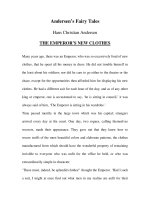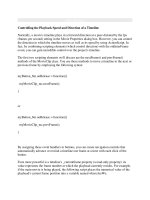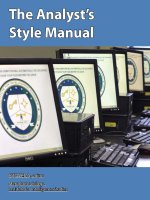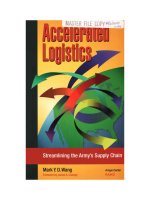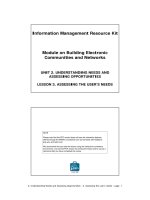The Lineman’s and Cableman’s Field Manual docx
Bạn đang xem bản rút gọn của tài liệu. Xem và tải ngay bản đầy đủ của tài liệu tại đây (3.43 MB, 385 trang )
The Lineman’s
and Cableman’s
Field Manual
Thomas M. Shoemaker,
P.E., B.S.E.E.
Life Senior Member, IEEE; Consulting Engineer;
Formerly: Manager, Distribution Department,
lowa-Illionis Gas & Electric Company;
Member,Transmission and Distribution
Committee, Edison Electric Institute;
Captain, Signal Corps, U.S. Army
James E. Mack, P.E.,
B.S.E.E., M.B.A.
Manager, Electric Reliability,
MidAmerican Energy Company;
Senior Member, IEEE;
Member, N.S.P.E.
Second Edition
New York Chicago San Francisco Lisbon London Madrid
Mexico City Milan New Delhi San Juan Seoul
Singapore Sydney Toronto
Copyright © 2009, 2000 by The McGraw-Hill Companies, Inc. All rights reserved. Except as
permitted under the United States Copyright Act of 1976, no part of this publication may be repro-
duced or distributed in any form or by any means, or stored in a database or retrieval system, without
the prior written permission of the publisher.
ISBN: 978-0-07-162122-9
MHID: 0-07-162122-9
The material in this eBook also appears in the print version of this title: ISBN: 978-0-07-162121-2,
MHID: 0-07-162121-0.
All trademarks are trademarks of their respective owners. Rather than put a trademark symbol after
every occurrence of a trademarked name, we use names in an editorial fashion only, and to the
benefit of the trademark owner, with no intention of infringement of the trademark. Where such
designations appear in this book, they have been printed with initial caps.
McGraw-Hill eBooks are available at special quantity discounts to use as premiums and sales
promotions, or for use in corporate training programs. To contact a representative please visit the
Contact Us page at www.mhprofessional.com.
Information contained in this work has been obtained by The McGraw-Hill Companies, Inc.
(“McGraw-Hill”) from sources believed to be reliable. However, neither McGraw-Hill nor its authors
guarantee the accuracy or completeness of any information published herein, and neither McGraw-Hill
nor its authors shall be responsible for any errors, omissions, or damages arising out of use of this
information.This work is published with the understanding that McGraw-Hill and its authors are sup-
plying information but are not attempting to render engineering or other professional services. If such
services are required, the assistance of an appropriate professional should be sought.
TERMS OF USE
This is a copyrighted work and The McGraw-Hill Companies, Inc. (“McGraw-Hill”) and its
licensors reserve all rights in and to the work. Use of this work is subject to these terms. Except as per-
mitted under the Copyright Act of 1976 and the right to store and retrieve one copy of the work, you
may not decompile, disassemble, reverse engineer, reproduce, modify, create derivative works based
upon, transmit, distribute, disseminate, sell, publish or sublicense the work or any part of it without
McGraw-Hill’s prior consent. You may use the work for your own noncommercial and
personal use; any other use of the work is strictly prohibited. Your right to use the work may be
terminated if you fail to comply with these terms.
THE WORK IS PROVIDED “AS IS.” McGRAW-HILL AND ITS LICENSORS MAKE NO GUAR-
ANTEES OR WARRANTIES AS TO THE ACCURACY, ADEQUACY OR COMPLETENESS OF
OR RESULTS TO BE OBTAINED FROM USING THE WORK, INCLUDING ANY INFORMA-
TION THAT CAN BE ACCESSED THROUGH THE WORK VIA HYPERLINK OR OTHERWISE,
AND EXPRESSLY DISCLAIM ANY WARRANTY, EXPRESS OR IMPLIED, INCLUDING BUT
NOT LIMITED TO IMPLIED WARRANTIES OF MERCHANTABILITY OR FITNESS FOR A
PARTICULAR PURPOSE. McGraw-Hill and its licensors do not warrant or guarantee that the
functions contained in the work will meet your requirements or that its operation will be uninterrupt-
ed or error free. Neither McGraw-Hill nor its licensors shall be liable to you or anyone else for any
inaccuracy, error or omission, regardless of cause, in the work or for any damages resulting therefrom.
McGraw-Hill has no responsibility for the content of any information accessed through the work.
Under no circumstances shall McGraw-Hill and/or its licensors be liable for any indirect, incidental,
special, punitive, consequential or similar damages that result from the use of or inability to use the
work, even if any of them has been advised of the possibility of such damages. This limitation of
liability shall apply to any claim or cause whatsoever whether such claim or cause arises in contract,
tort or otherwise.
Contents
Preface ix
Acknowledgments xi
Chapter 1. The Electric System 1
Electrical Drawing Symbols 1
Pictorial Representation of an Electric System 4
Units of Measurement 7
Metric equivalents 8
Temperature 9
Definitions 9
Formulas and Calculations 10
Direct-current circuits 11
Series-resistive circuit 12
Parallel-resistive circuit 12
Alternating-current circuits 15
Power factor correction 20
Electrical Apparatus 22
Motors 22
Alternating-current generator 24
Transformer (single-phase) 25
Summary of Electrical Formulas 25
Current 27
Voltage 28
Resistance 28
Power loss 28
Impedance 28
Power 29
Volt-amperes 29
Power factor 29
Motor 30
Chapter 2. Line Conductors 33
Types 33
Definitions 33
Wire Sizes 55
Sagging Conductors 57
iii
Chapter 3. Cable, Splices, and Terminations 61
15-kV Underground Distribution Cable Layers 61
Other Examples of Cable Layering 62
Oil-filled cable 63
Transmission cable 63
Self-contained transmission cable 64
Conductor Metal Types 64
Conductor Composition 64
Conductor Shapes 65
Insulation Compounds 65
Insulation Thickness 65
Sample Cable Specifications 66
15-kV XLP insulated 4/0-AWG aluminum cable with jacketed
concentric neutral 66
Production tests 67
Insulation tests 67
Dimensional verification 68
Electrical stress distribution 69
Terminations (electrical stress minimization) 69
Live-front applications 70
Dead-front applications 70
Dead-front load-break elbow termination detail 71
In-line cable splices 72
Cold shrink splices 72
Temperature Correction Tables 75
Temperature Correction Formula 77
Adjustment for other temperatures 77
Sample calculation 77
Chapter 4. Distribution Voltage Transformers 79
Distribution Voltage Transformer Definition 79
Alternating-Current Electric Voltage
Step-Down Transformer 79
Transformer Components 79
Transformer Formulas 80
Transformer turns ratio formula 80
Primary to secondary voltage and current
relationship 81
Distribution Transformer Ratings 81
Distribution Transformer Specifications 82
Overhead conventional distribution transformer 82
Overhead Completely Self-Protected (CSP)
Distribution Transformer 84
Single-Phase Pad-Mounted Distribution
Transformer 86
Three-Phase Pad-Mounted Distribution Transformer 88
Transformer Polarity 90
Polarity tests for overhead distribution
transformers 90
Distribution transformer connections 91
iv Contents
Contents v
Chapter 5. Wood-Pole Structures 99
Wood-Pole Types 99
Wood-Pole Preservatives 99
Wood-Pole Classifications, Dimensions, and Weights 99
Pole Hole Depths 103
Wood-Pole Construction Standards Examples 104
Chapter 6. Guying 115
Definitions 115
Conductor Breaking Strengths 116
Guy Size Determination 121
Computing the load on the guy 123
Computing the guy angle factor 124
Chapter 7. Lightning and Surge Protection 127
Definitions 127
Classes of Surge Arresters 128
Valve Block Types of Surge Arresters 128
Surge Arrester Selection Criteria 132
Insulation protective margin equation 132
Chapter 8. Fuses 141
Definitions 141
Fuse Links 141
Standard Fuse Link Ratings 141
Distribution Cutouts 141
Enclosed cutouts 144
Open distribution cutouts 144
Open-link primary cutout 145
Fuse operation diagram 145
Time-Current Characteristic Curves 146
Protective Fuse to Fuse Overcurrent Coordination 146
Transformer Fusing Schedules 146
Fuse to Fuse Overcurrent Coordination 148
Chapter 9. Inspection Checklists for Substations, Transmission
Lines, and Distribution Lines 157
Substation Inspection 157
Transmission-Line Inspection 158
Initial inspection 158
Aerial inspections 159
Walking inspections 159
Distribution-Line Inspection Checklist 159
Distribution-Line Equipment Maintenance 160
Capacitor maintenance 160
Recloser maintenance 161
Pole-mounted switch maintenance 161
Underground distribution circuit maintenance 161
Riser pole maintenance 162
Switchgear maintenance 162
Distribution transformer maintenance 162
Underground cable maintenance 162
Street light maintenance 163
Voltage regulator maintenance 164
Maintenance of Equipment Common to Transmission
and Distribution Lines 164
Pole maintenance 164
Insulator maintenance 166
Conductor maintenance 166
Chapter 10. Tree Trimming 169
Industry Standards 169
Definitions 169
Trimming Branches and Limbs 171
Lowering Large Limbs 172
Vehicular Equipment 172
Tools 173
Trimming Tables 174
Chapter 11. Rope, Knots, Splices, and Gear 179
Chapter 12. Grounding 205
Codes 205
Definitions 205
Ground Rods 205
Transmission-Line Grounds 208
Grounding Coils and Grounding Plates 210
Counterpoise 214
Distribution-Circuit Grounds 216
Installing Driven Grounds 217
Ground-Wire Molding 220
Chapter 13. Protective Grounds 223
Reference Standard 223
Protective Ground Installation 226
Protective Ground Requirements 228
Sources of Ground 228
Underground-System Protective Grounds 230
Chapter 14. Safety Equipment and Rescue 237
United States Occupational Safety and Health
Administration (OSHA) Safety Rules 237
National Electrical Safety Code 237
National Electrical Code
®
237
vi Contents
De-energized Work 238
Hot-Line Work 238
Protective Equipment 238
Rubber gloves 239
Rubber sleeves 242
Rubber insulating line hose 242
Rubber insulating insulator hoods 243
Conductor covers 243
Insulator covers 243
Crossarm covers 244
Pole covers 244
Rubber insulating blankets 244
Safety hat 244
Resuscitation 245
First-aid equipment 246
What to do in an emergency 246
Effects of electric shock on the human body 247
Rescue 247
Freeing the victim 247
Artificial respiration methods 248
Applying artificial respiration 249
The need for speed 249
Use protective barriers 249
Assess your victim 250
Check for pulse 250
Mouth-to-nose rescue breathing 251
If a pulse is present, but the person is not
breathing, begin rescue breathing 251
Airway obstruction: conscious adult 252
Conscious adult choking victim who becomes unconscious 254
How to do a finger sweep 254
What to do when the object is cleared 254
If you are alone and choking 254
What to do if your victim is pregnant or large 254
Heart-lung resuscitation: cardiopulmonary
resuscitation (CPR) 255
Why do I do that and why did they change? 256
Pole-Top and Bucket-Truck Rescue 261
Basic steps in pole-top rescue 261
Personnel tools and rubber gloves
(rubber sleeves, if required) 262
Determine the injured’s condition 263
Rescuer 264
Tying the injured 264
Important 265
Lowering the injured 265
One-man rescue versus two-men rescue 265
Bucket-truck rescue 266
Important 267
Chapter 15. OSHA § 1910.269 269
OSHA Regulations (Standards—29 CFR): Electric Power Generation,
Transmission, and Distribution (1910.269) 269
Interpretation(s) 269
Contents vii
Appendix A to § 1910.269—Flowcharts 338
Appendix B to § 1910.269—Working on Exposed Energized Parts 341
I. Introduction 341
II. General 343
III. Determination of the electrical component of minimum
approach distances 344
IV. Determination of reduced minimum approach distances 349
Appendix C to § 1910.269—Protection from Step and Touch Potentials 357
I. Introduction 357
II. Voltage-gradient distribution 358
Appendix D to § 1910.269—Methods of Inspecting and Testing
Wood Poles 361
I. Introduction 361
II. Inspection of wood poles 361
III. Testing of wood poles 362
Appendix E to § 1910.269—Reference Documents 362
Index 367
viii Contents
Preface
The Lineman’s and Cableman’s Field Manual is written to accompany
The Lineman’s and Cableman’s Handbook. The Field Manual contains
many of the same pertinent tables, charts, formulas, and safety rules that
are found in the Handbook. The goal of the Field Manual is to provide
the information that is needed on the job site in a format that can be
quickly and easily accessed. This customizable tool provides specially
designed notes pages for personal notes. It is written for the apprentice,
the lineman, the cableman, the foreman, the supervisor, and other
employees of electric line construction contractors and transmission and
distribution departments of electric utility companies. The Field Manual
contains definitions of electrical terms and diagrams of electric power sys-
tems, plus sections devoted to line conductors; cables, splices, and ter-
minations; distribution voltage transformers; guying; lightning and surge
protection; fuses; inspection and maintenance plans; tree trimming; rope,
knots, splices, and gear; grounding; protective grounds; and safety equip-
ment and rescue.
Safety is emphasized throughout this book. Occupational Safety
and Health Administration (OSHA) Regulation (Standards—29 CFR)
1910.269, Electric Power Generation, Transmission, and Distribution,
has been included due to its significance to the industry and for the
safety of the individual. Of course, understanding the principles
involved in any operation and knowing the reasons for doing things a
given way are the best aids to safety. The opinion has become quite
firmly established that a person is not a good lineman unless he does
his work in accordance with established safety procedures and with-
out injury to him or others. It is necessary for those engaged in elec-
trical work to know the safety rules and the precautions applicable to
their trades as specified in the National Electrical Safety Code, OSHA
standards, and their employer’s safety manuals and standards. Observing
safety rules and procedures must be an inseparable part of their work-
ing habits.
ix
This Field Manual places emphasis on the National Electrical Safety
Code, OSHA standards, ANSI standards, and ASTM standards. Important
requirements of all of these are discussed, but also they should be stud-
ied for detailed work procedures. Many applicable codes and standards
are specified throughout the text to assist the reader.
The lineman and the cableman must become acquainted with the
minimum construction requirements and maintenance and operating
procedures in the various codes and standards to ensure the safety of
the public and all workers. A copy of the National Electrical Safety Code
(ANSI C2) can be secured for a fee from the Institute of Electrical and
Electronics Engineers, Inc., 3 Park Avenue, 17th Floor, New York, NY
10016. All linemen and cablemen must know the information in the
National Electrical Safety Code and adhere to the rules and procedures
while performing their work assignments.
The National Electrical Code
®
details the rules and regulations for
electrical installations, except those under the control of an electric
utility. It excludes any indoor facility used and controlled exclusively by
a utility for all phases from the generation through the distribution of
electricity and for communication and metering, as well as outdoor facil-
ities on a utility’s own or a leased site or on public or private (by estab-
lished rights) property.
The editors are well aware that one cannot become a competent line-
man or cableman from a study of the pages of this book alone. However,
diligent study along with daily practical experience and observation
should give the apprentice an understanding of construction and main-
tenance procedures—and a regard for safety—that should make his
progress and promotion rapid.
Thomas M. Shoemaker
James E. Mack
x Preface
Acknowledgments
The editors are deeply indebted to several companies noted throughout
the Field Manual and their representatives for contributions. The editors
are also indebted to the Institute of Electrical and Electronics Engineers,
Inc., publisher of the National Electrical Safety Code; the American
National Standards Institute; Electric Light and Power; the Rural
Electrification Administration; McGraw-Hill, publisher of the Standard
Handbook for Electrical Engineers, and of Electrical World; Transmission
& Distribution; and the Edison Electrical Institute, for permission to
reprint various items from its literature.
xi
The terms lineman and cableman, long-established and still current in
the industry, are beginning to be replaced by nonsexist titles in official doc-
uments and government publications. Both men and women are employed
in these capacities in the military and in the industry. To avoid awkard-
ness, this Field Manual uses the masculine pronoun, but it in no way
implies that the jobs involved are held only by men.
Chapter
1
The Electric System
Electrical Drawing Symbols
Diagrams of electric circuits show the manner in which electrical devices
are connected. Because it would be impossible to make a pictorial draw-
ing of each device shown in a diagram, the device is represented by a
symbol.
A list of some of the most common electrical symbols used follows. It
is noted that the symbol is a sort of simplified picture of the device
represented.
The reader is encouraged to review IEEE Standard 315/ANSI
Y32.2/CSA Z99, Graphic Symbols for Electrical and Electronics
Diagrams.
1
2 Chapter One
The Electric System 3
Pictorial Representation
of an Electric System
For a pictorial overview of the different parts of an electric system, see
Figs. 1.1 through 1.4.
4 Chapter One
Figure 1.1 A simple model of the entire process of generation, transmission,
and distribution of electricity.
5
Figure 1.2 A single-line schematic of the entire process.
6
Figure 1.3 A single-line diagram of a distribution circuit.
Units of Measurement
Time
1 minute ϭ 60 seconds
1 hour ϭ 60 minutes ϭ 3,600 seconds
1 day ϭ 24 hours ϭ 1,440 minutes ϭ 86,400 seconds
60-hertz AC electric system (60 cycles per second)
1 second ϭ 60 cycles
100 milliseconds ϭ 6 cycles
250 milliseconds ϭ 15 cycles
500 milliseconds ϭ 30 cycles
The Electric System 7
Figure 1.4 A single-line schematic of a distribution circuit.
Length
1 foot ϭ 12 inches
1 yard ϭ 3 feet ϭ 36 inches
1 mile ϭ 1,760 yards ϭ 5,280 feet ϭ 63,360 inches
Decimal units
milli- 10
Ϫ3
centi- 10
Ϫ2
deci- 10
Ϫ1
kilo- 10
3
mega- 10
6
Metric equivalents
U.S. to metric
1 inch ϭ 0.0254 meter ϭ 2.54 centimeters ϭ 25.4 millimeters
2 inches ϭ 0.0508 meter ϭ 5.08 centimeters ϭ 50.8 millimeters
3 inches ϭ 0.0762 meter ϭ 7.62 centimeters ϭ 76.2 millimeters
4 inches ϭ 0.1016 meter ϭ 10.16 centimeters ϭ 101.6 millimeters
5 inches ϭ 0.1270 meter ϭ 12.70 centimeters ϭ 127.0 millimeters
6 inches ϭ 0.1524 meter ϭ 15.24 centimeters ϭ 152.4 millimeters
7 inches ϭ 0.1778 meter ϭ 17.78 centimeters ϭ 177.8 millimeters
8 inches ϭ 0.2032 meter ϭ 20.32 centimeters ϭ 203.2 millimeters
9 inches ϭ 0.2286 meter ϭ 22.86 centimeters ϭ 228.6 millimeters
10 inches ϭ 0.2540 meter ϭ 25.40 centimeters ϭ 254.0 millimeters
11 inches ϭ 0.2794 meter ϭ 27.94 centimeters ϭ 279.4 millimeters
1 foot ϭ 0.3048 meter ϭ 30.48 centimeters ϭ 304.8 millimeters
1 yard ϭ 0.9144 meter ϭ 91.44 centimeters ϭ 914.4 millimeters
1 mile ϭ 1609.35 meters ϭ 1.60935 kilometers
Metric to U.S.
1 millimeter ϭ 0.03937 inch
1 centimeter ϭ 0.39370 inch
1 meter ϭ 1.09361 yards ϭ 3.28083 feet ϭ 39.3700 inches
1 kilometer ϭ 0.62137 mile
8 Chapter One
Temperature
Centigrade to Fahrenheit Fahrenheit to Centigrade
ЊC ϭ (5/9)(ЊFϪ32) ЊF ϭ (9/5)ЊC ϩ 32
0ЊC ϭ 32ЊF0ЊF ϭϪ17.8ЊC
10ЊC ϭ 50ЊF10ЊF ϭϪ12.2ЊC
20ЊC ϭ 68ЊF20ЊF ϭϪ6.7ЊC
30ЊC ϭ 86ЊF30ЊF ϭϪ1.1ЊC
40ЊC ϭ 104ЊF32ЊF ϭ 0ЊC
50ЊC ϭ 122ЊF40ЊF ϭ 4.4ЊC
60ЊC ϭ 140ЊF50ЊF ϭ 10.0ЊC
70ЊC ϭ 158ЊF60ЊF ϭ 15.6
ЊC
80ЊC ϭ 176ЊF70ЊF ϭ 21.1ЊC
90ЊC ϭ 194ЊF80ЊF ϭ 26.7ЊC
100ЊC ϭ 212ЊF90ЊF ϭ 32.2ЊC
100ЊF ϭ 37.8ЊC
Definitions
■
Voltage (E) The electric force of work required to move current
through an electric circuit, measured in units of volts.
■
Volt (V) The unit of measurement of voltage in an electric circuit,
denoted by the symbol V.
■
Current (I) The flow of free electrons in one general direction,
measured in units of amps.
■
Amp (A) The unit of measurement of electric current, denoted by
the symbol A.
■
Direct-Current (dc) Current that flows continually in one direction.
■
Alternating-Current (ac) Current that flows in a circuit in a pos-
itive direction and then reverses itself to flow in a negative direction.
■
Resistance (R) The electrical “friction” that must be overcome
through a device in order for current to flow when voltage is applied.
■
Ohm (⍀) The unit of measurement of resistance in an electric cir-
cuit, denoted by the symbol ⍀.
■
Inductance (H) The property that causes the current to lag the volt-
age, measured in units of henries.
■
Capacitance (F) The property that causes the current to lead the
voltage, measured in units of farads.
The Electric System 9
■
Energy (Wh) The amount of electric work (real power) consumed
or utilized in an hour. The unit of measurement is the watt hour.
■
Power (P) The combination of electric current and voltage causing
electricity to produce work. Power is composed of two components: real
power and reactive power.
■
Volt-Ampere (VA) The unit of both real and reactive power in an
electric circuit.
■
Real Power The resistive portion of a load found by taking the
cosine (⌰) of the angle that the current and voltage are out of phase.
■
Watt (W) The unit of real power in an electric circuit.
■
Reactive Power The reactive portion of a load, found by taking the
sine (⌰) of the angle that the current and voltage are out of phase.
■
Var (Q) The unit of reactive power in an electric circuit.
■
Power Factor (pf) The ratio of real power to reactive power.
■
Frequency (f) The number of complete cycles made per second,
measured in units of hertz.
■
Hertz (Hz) Units of frequency (equal to 1 cycle per second).
■
Conductors Materials that have many free electrons and are good
transporters for the flow of electric current.
■
Insulators Materials that have hardly any free electrons and inhibit
or restrict the flow of electric current.
■
Series Resistive Circuit All of the resistive devices are con-
nected to each other so that the same current flows through all the
devices.
■
Parallel Resistive Circuit Each resistive device is connected
across a voltage source. The current in the parallel path divides and
only a portion of the current flows through each of the parallel
paths.
Formulas and Calculations
In this section, the most common electrical formulas are given and their
use is illustrated with a problem. In each case the formula is first stated
by using the customary symbols, the same expression is then stated
in words, a problem is given, and finally the substitutions are made for
the symbols in the formula from which the answer is calculated. Only
those formulas which the lineman is apt to have use for are given. The
formulas are divided into three groups: dc circuits, ac circuits, and elec-
trical apparatus.
10 Chapter One
Direct-current circuits
Ohm’s law.
The formula for Ohm’s law is the most fundamental of all
electrical formulas. It expresses the relationship that exists in an elec-
tric circuit containing resistance only between the current flowing in the
resistance, the voltage impressed on the resistance, and the resistance
of the circuit:
where I ϭ current, amps
E ϭ voltage, volts
R ϭ resistance, ohms
Expressed in words, the formula states that current equals voltage
divided by resistance, or:
Example: How much direct-current will flow through a resistance of 10 ohms if
the pressure applied is 120 volts direct-current?
Solution:
Ohm’s law involves three quantities: current, voltage, and resistance. Therefore,
when any two are known, the third one can be found. The procedure for solving
for current has already been illustrated. To find the voltage required to circulate
a given amount of current through a known resistance, Ohm’s law is written as:
E ϭ IR
In words, the formula says that the voltage is equal to the current multiplied by
the resistance; thus:
Example: How much direct-current (dc) voltage is required to circulate 5 amps
direct current through a resistance of 15 ohms?
Solution:
In like manner, if the voltage and current are known and the value of resistance
is to be found, the formula is:
R 5
E
I
E 5 IR 5 5 3 15 5 75 volts
Volts 5 amperes 3 ohms
I 5
E
R
5
120
10
5 12 amps
Amperes 5
volts
ohms
I 5
E
R
The Electric System 11
Expressed in words, the formula says that the resistance is equal to the voltage
divided by the current; thus:
Example: What is the resistance of an electric circuit if 120 volts direct-current
causes a current of 5 amps to flow through it?
Solution:
Series-resistive circuit
Example: The 12-volt battery has three lamps connected in series (Fig. 1.5). The
resistance of each lamp is 8 ohms. How much current is flowing in the circuit?
Solution: In a series-resistive circuit, all values of resistance are added together,
as defined by the formula:
Therefore: R ϭ 8 ϩ 8 ϩ 8 ϭ 24 ohms
Parallel-resistive circuit
Example: The 12-volt battery has three lamps connected in parallel (Fig. 1.6). The
resistance of each lamp is 8 ohms. How much current is flowing in the circuit?
Solution: In a parallel-resistive circuit, all values of resistance can be added
together, as defined by the formula:
1/R
parallel
5 1/R
1
1 1/R
2
1
. . .
1 1/R
n
and because I 5 E/R
5 12/24
5 0.5 amp
R
series
5 R
1
1 R
2
1
. . .
1 R
n
5 R
total
R 5
E
I
5
120
5
5 24 ohms
Ohms 5
volts
amperes
12 Chapter One
Figure 1.5 A series circuit. The same current flows through all the
lamps.
